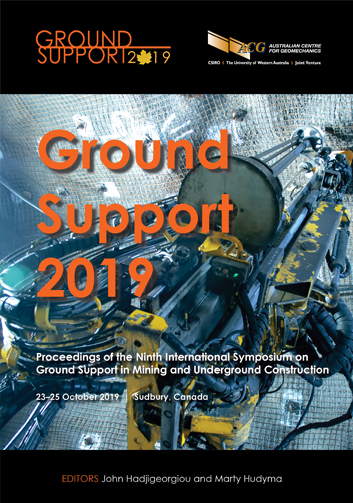Application of the Geological Strength Index in Peruvian underground mines: retrospective 18 years after its implementation

|
Authors: Mejia Camones, LA; Chacon Nunez, C |
DOI https://doi.org/10.36487/ACG_rep/1925_32_Mejia
Cite As:
Mejia Camones, LA & Chacon Nunez, C 2019, 'Application of the Geological Strength Index in Peruvian underground mines: retrospective 18 years after its implementation', in J Hadjigeorgiou & M Hudyma (eds), Ground Support 2019: Proceedings of the Ninth International Symposium on Ground Support in Mining and Underground Construction, Australian Centre for Geomechanics, Perth, pp. 459-470, https://doi.org/10.36487/ACG_rep/1925_32_Mejia
Abstract:
Historically, underground Peruvian mining has been considered high-risk work. In 2000, 55 fatal accidents were reported and this number increased to 74 in 2002. Rockfall is the cause of around 30% to 40% of these incidences. In 2000, changes within company work policies were done in order to increase the safety and productivity in underground excavations. Thus, geomechanical departments were implemented in order to improve mine planning, to optimise the use of rock supports, to zone the mine according to the rock mass quality and to increase safety levels by reducing accidents due to rockfall. Regarding the use of rock mass quality technique, some companies chose the Q-index (Barton et al. 1974) and others chose the Rock Mass Rating (RMR) (Bieniawski 1979) to perform geomechanics in the mining operations. While these geomechanical classification indices improved the operation, they were not suitable for general use by workers, principally because several of the input parameters had to be determined using technical knowledge. It was important to find a rating system that allowed all workers to be able to evaluate the risk before entering an excavation and/or determining if the excavation needs support. Accordingly, the Geological Strength Index (GSI; Hoek & Brown 1997) was chosen as the best option. In 2002, the practical mining support (SPM) table was introduced (Vallejo, 2002) and the GSI table—including the support types associated with the rock mass quality—was implemented. This new table was easy to be learn and read, and allowed all operational workers to be able to evaluate the rock mass and allowed the geomechanical engineers to integrate all the information of the mine into a single geomechanical classification system. This paper aims to address the process of implementing the GSI in underground Peruvian mining, as well as presenting the process of construction of the Geomechanical Tables and the impact that this system has in the reduction of accidents and in productivity improvements. Currently, after 18 years, almost all Peruvian underground mines have adapted the GSI table for their operations and consider the GSI table part of the worker’s personal protective safety equipment.
Keywords: rock mass classification, Geological Strength Index, Geomechanical Tables
References:
Barton, N, Lied, R & Lunde, J 1974, ‘Engineering classification of rock masses for the design of tunnel support’, Rock Mechanics, vol. 6, no. 4, pp. 183‒236.
Bieniawski, ZT 1979, ‘The geomechanics classifications in rock engineering applications’, Proceedings of the Fourth ISRM Congress, Montreux, Switzerland.
Bieniawski, ZT 1989, Engineering Rock Mass Classifications, Wiley, New York.
Hoek, E & Brown, ET 1997, ‘Practical estimates of rock mass strength’, International Journal of Rock Mechanics and Mining Sciences, vol. 34, no. 8, pp. 1165–1186.
Hoek, E, Kaiser, P & Bawden, W 1995, ‘Support of underground excavations in hard rock’, A.A. Balkema, Rotterdam.
Vallejo, C 1999, ‘Descripción y aplicaciones prácticas del Índice G.S.I. (Geological Strength Index) en excavaciones subterráneas (in Spanish)’, Proceedings of XII National Congress of Civil Engineering, Peruvian Civil Engineering Council – Council of Huanuco.
Vallejo, C 2002, ‘Aplicaciones del Indice G.S.I. (Geological Strength Index) para el Mapeo Geomecánico y la definición del Sostenimiento de laboures Mineras subterráneas (in Spanish)’, Proceedings of XI Peruvian Congress of Geology, Lima.
© Copyright 2025, Australian Centre for Geomechanics (ACG), The University of Western Australia. All rights reserved.
View copyright/legal information
Please direct any queries or error reports to repository-acg@uwa.edu.au
View copyright/legal information
Please direct any queries or error reports to repository-acg@uwa.edu.au